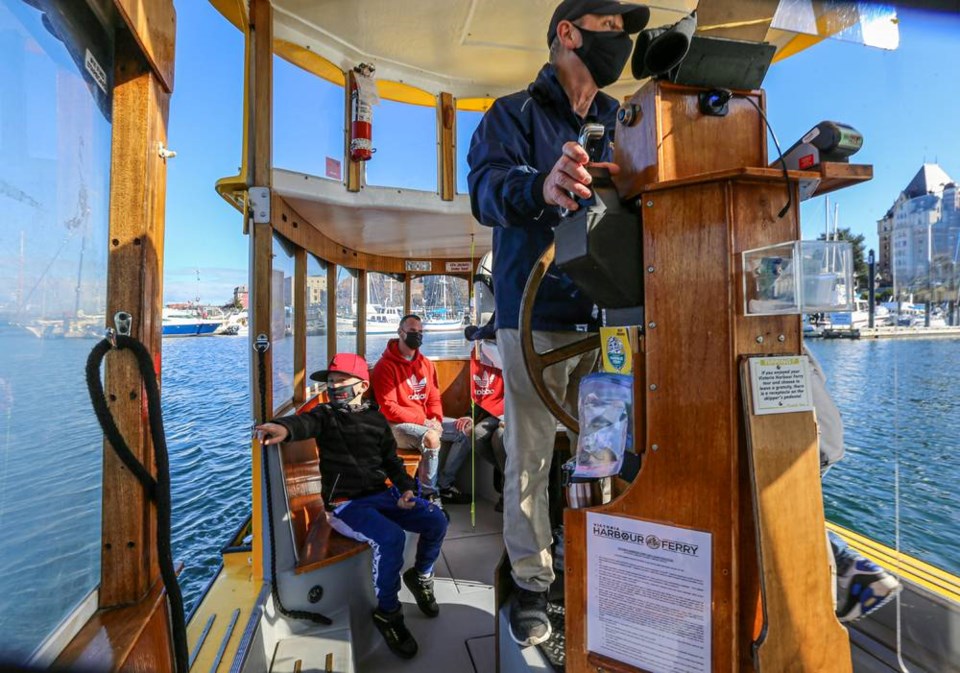Three little ferries chugged out of pandemic hibernation on Monday with payloads of happy locals and a cautious optimism that a tourism season of some form is on the horizon.
The Victoria Harbour Ferry Co., long a bellwether of Greater Victoria’s tourism industry, hit the rocks last year as COVID-19 travel restrictions and the closure of the U.S. border brought a 70% decline in ridership and revenue, leaving more than half of the 17-vessel fleet docked most of the year.
“Obviously we’re not expecting a wild influx of tourists, but we wanted to be out there and be all about our local community,” said Victoria Harbour Ferry general manager Barry Hobbis.
“We want to get locals out on the water to relax and enjoy the views, take the kids to Fisherman’s Wharf or travel up the Gorge. A lot of people have been at home for months.”
The company will launch more of their vessels as demand increases, including one of its four electric boats for tours of the Gorge Waterway.
Hobbis said although a return to normal tourism is likely still a year away “there is a light at the end of the tunnel.”
Like many tourism operators, he’s watching the vaccination rollouts in B.C. and across Canada and what are likely to be loosening restrictions on travel further into spring and summer.
Prince of Whales, the province’s largest whale-watching company, took a cautious foray out of the water over the weekend, taking two zodiacs and a handful of passengers on three-hour tours.
The Victoria-based company with operations in Vancouver and Telegraph Cove shut down for the first time in its 27-year history in November, docking its entire fleet and laying off more than 50 staff.
Ian MacPhee, the company’s controller, said one of its larger vessels with a capacity of 95 passengers but halved for the pandemic will be brought into service this weekend in Victoria for spring break.
Reservations are trickling in, said MacPhee. The company is offering winter rates through the spring, but so far the response is nowhere close to normal.
“Our bookings in March are about 8% of what they were in March 2019,” he said. “But we were zero in December, January and February, so 8% is something. It helps pay for gas and staff.”
Prince of Whales’ Vancouver operations will open April 1 and Telegraph Cove in early May, said MacPhee, and they will all follow COVID protocols.
He said the kayaking tour company acquired last year at Telegraph Cove is also seeing some bookings this spring.
Dr. Bonnie Henry, the provincial health officer, announced last week an easing of restrictions on gatherings, saying groups of up to 10 people are allowed to gather outdoors.
MacPhee expects to operate at about half capacity this year, but is hopeful it could be more. Like most tourism companies, it is being flexible with prices and booking policies.
He said some of what’s lost on the tourism shutdown is the effect on workers. “You can’t underestimate the impact of their mental health through all this,” MacPhee said. “So it’s important to get the boats out on the water when it’s safe to do so.”
The Homalco First Nation in Campbell River has announced an expansion of its touring operations. It will open a new adventure centre and launch two new passenger vessels for tours to view whales and wildlife and significant cultural sites over its traditional territory.
Anthony Everett, president and CEO of Tourism Vancouver Island, said a new tourism season with COVID-19 still a threat leaves a lot of unknowns for the hundreds of companies in the sector.
“There is a pent up demand and people want to travel, but it will be complicated [for tourism companies],” he said. All are watching public health orders on a daily basis for any new guidelines that will affect planning and staffing.
“Businesses need timing and certainty … and that will linger” for most of the year, said Everett.
He noted a North Island kayaking excursion company that during a normal year is booked 90% by this time early in the season. Last year the company adjusted to 20% of its revenue by serving only locals. “This whole winter they’ve been working to build on that and push it to 30%. For a lot of companies, it’s about survival at this point.”



